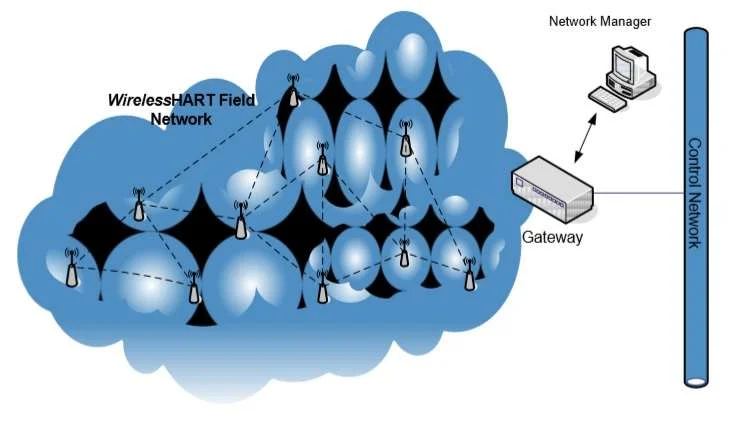WirelessHART basics
This page on WirelessHART covers WirelessHART basics,applications,frequency band,protocol stack covering physical layer and wirelessHART datalink layer.
WirelessHART is a Wireless Mesh Network Communications Protocol designed to meet the needs for process automation applications. Like all things HART, WirelessHART is backward compatible with existing HART devices and applications. Existing HART applications (e.g., control systems, PLCs, maintenance tools, and asset management applications) can utilize WirelessHART without the need for software upgrades. WirelessHART is a secure and robust mesh networking technology operating in the 2.4GHz ISM radio band. WirelessHART utilizes IEEE 802.15.4 compatible DSSS radios with channel hopping on a packet by packet basis. WirelessHART is designed as per IEEE STD 802.15.4-2006 compatible Physical Layer and MAC PDU described below in brief. Let us see WirelessHART protocol stack.

The figure-1 depicts WirelessHART network architecture. There are six devices which form wirelessHART network. They are field device, adapter, gateway, network manager, security manager and handheld device. Field devices having routing features are installed everywhere which collects necessary information. These informations are transported to plant network for process monitoring and control.
WirelessHART PHYSICAL LAYER
The WirelessHART physical layer is based mostly on the IEEE STD 802.15.4-2006 2.4GHz DSSS physical layer. This layer defines radio characteristics, such as the signaling method, signal strength, and device sensitivity. Just as IEEE 802.15.4.
WirelessHART supports RF frequency band of 2400-2483.5 MHz license-free ISM band with a data rate of up to 250 kbits/s. The channels supported here are from 11 to 26, with a 5MHz gap between two adjacent channels.
• Data Rate : 250KBPS (62.5 KBAUD)
• Operating Frequency : 2400-2483.5 MHz
• Modulation : O-QPSK; Direct Sequence Spread Spectrum (DSSS)
• Transmit Power : about 10dBm adjustable in discrete steps (e.g., 0dBM and others).
• PDU : IEEE compliant Physical Layer PDU, Maximum payload 127 bytes.
WirelessHART DATA LINK LAYER
In this section we will see wirelessHART data link layer. WirelessHART defines a strict 10ms time slot and utilizes TDMA technology to provide collision free and deterministic communications. The concept of super frame is introduced to group a sequence of consecutive time slots.
In WirelessHART, transaction in one time slot is described by following vector:
{frame id, index, type, src addr, dst addr, channel offset}
Where,
frame id identifies the secific super frame;
index is the index of the slot in the super frame;
type indicates the type of the slot (transmit/receive/idle);
src add and dst addr are the addresses of the source device and destination device, respectively;
channel offset means the logical channel to be used for transaction.
Bus Arbitration: TDMA using timeslots organized into super frames as mentioned above:
• 100 timeslots per second
• All devices support multiple super frames with differing numbers of timeslots to allow mixing of fast (1 second), slow (minutes), cyclic and acyclic network traffic. Super frames may be enabled and disabled based on bandwidth demand.
• Communication occurs in designated timeslot and frequency channel for that message.
• Acknowledgement packets include timing information to continuously synchronize TDMA operation across entire network.
WirelessHART REFERENCES:
IEEE 802.15.4-2006 DSSS
https://www.hartcomm.org/
Product vendors
https://www.rfm.com/
https://www.e-senza.com/
IoT Wireless Technologies
➤WLAN ➤THREAD ➤EnOcean ➤LoRa ➤SIGFOX ➤WHDI ➤Zigbee ➤6LoWPAN ➤Zigbee RF4CE ➤Z-Wave ➤NFC ➤RFID ➤X10 ➤INSTEON
